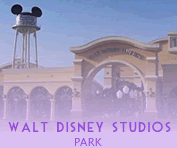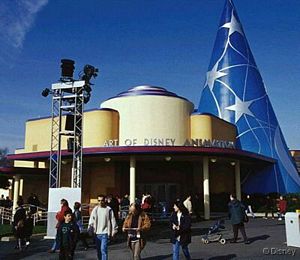
|

Art of Disney Animation
|
|
|

A towering "Sorcerer's Apprentice" hat, inspired by the one worn by Mickey Mouse in the Disney classic, Fantasia, is the distinctive exterior feature of the Art of Disney Animation. Since the creation of the Disney Brothers Cartoon Studios in Hollywood in 1923, animation has been the cornerstone of the Disney universe. This interactive attraction pays tribute to this very particular form of art, where some of the secrets of Disney animation are revealed for the very first time.
In the attraction's pre-show area, a colourful mural presents many of the landmarks in the history of the moving image, from its origins in the cave paintings of Altamira, Spain, that date from 15,000 B.C. to the great European inventors that challenged their imaginations - and each other - over the centuries to animate images. Guests can create some dazzling animation themselves when operating some of the "persistence of vision" apparatus exhibited here. Some of the early reference points in the history of animation featured include a Greek Urn, a Japanese shadow puppet, a Zoetrope, a Phenakistoscope, a Thaumatrope, a Magic Lantern and a Praxinoscope.
A treasure of a camera
This same room also features drawings from some of the first Disney films, including the Alice Comedies (1924-1927) and Snow White and the Seven Dwarfs (1937). Also on display in this area is one of only two remaining multi-plane cameras, a revolutionary animation tool that was developed by Walt Disney in the 1930's. The multi-plane camera allowed for different parts of the same image to be animated independently, thus creating the illusion of depth. The Old Mill (1937) was the first film to be animated using this technique, as was the first feature length animated film in the history of cinema - Snow White and the Seven Dwarfs. Before the doors to the Disney Classic Theater open, a film featuring Walt Disney is shown on a video screen. Walt Disney pays tribute to the European pioneers of animation before his nephew, Roy Disney, Chairman of Walt Disney Feature Animation, takes over to underline the importance of history to animated films. This film is presented in English, with subtitles in six European languages (English, French, German, Dutch, Spanish and Italian).
The emotion of the Disney classics
Guests enter the 225-seat Disney Classics Theater, which takes its theme from the private "screening rooms" that can be found in all Hollywood movie studios. Guests are invited to experience an eight-minute film that pays tribute to the very best of Disney animation. The film features a variety of poignant, moving and funny images from many of the magical Disney classics. The original sound track for this film is made up of music and songs that many a movie-goer will recognise, including excerpts from Pinocchio, Pocahontas, Cinderella, Peter Pan, Bambi and 101 Dalmatians.
The genesis of a character
Guests leave the Disney Classics Theater for Drawn to Animation, a second room themed on an animator's drawing desk. In addition to two over-sized monitors, the stage is filled with toys, books and models, which create a colourful and playful atmosphere. Sat at a desk on stage, an artist begins to detail the creative processes for an animated film. The show is in French, but headsets offer guests the possibility of simultaneous translation in either English, German, Dutch, Spanish or Italian.
To demonstrate how characters are created, the artist enlists the help of Mushu, the little red dragon from Mulan. Mushu doesn't believe his ears when he discovers that he is an animated film character - he insists that he has "always been a real dragon!". A surreal conversation begins between the character and the artist, each trying to prove his good faith by all means possible.
A dragon lets off steam
Given the little dragon’s refusal to accept that he is an animated character, the artist calls on a friend who appears on the video screen above him. This is Chris Sanders, one of Mushu’s creators. In just a few moments, Chris gives a demonstration that not only sees Mushu get a little 'hot under the collar', but also proves to the little red dragon that he is indeed a hero from an animated film.
Tom Bancroft, one of Disney's character animators, then appears on the screen, and illustrates that a great amount of painstaking research went into the creation of Mushu, whose origins can be traced back to some very ancient Chinese paintings. Upon hearing this, Mushu is understandably proud of being the animated 'descendant' of the greatest dragons of Chinese folklore.
Bringing characters to life
Guests now discover how all of these characters are bought to life and given movement. A video film projected on the screen shows amazing footage of the animators themselves playing out the scenes, followed by real footage of these actions enacted by 'cartoon' characters.
Pam Coats, the producer of Mulan, appears on the screen, surrounded by the creative team from the movie. When Mushu recognises them, he jumps from one screen to another, greeting this group of old friends. On stage, the artist invites the audience to discover many more Disney characters, as well as offering guests a tantalising glimpse of forthcoming Disney features. Meanwhile, the little dragon, who has now discovered how animated movie characters are created, cannot help himself from imagining how, in the future, he could be the star of Snow White and the Seven Mushus or, better yet, The Mushu of Notre-Dame!
Discovering the secrets of animation
'Animation stations' await guests in the last room of the attraction, where a range of experiences are available to help them improve their knowledge and understanding of the art of animation. The interactive stations feature instructions in six European languages.
Animation Academy – An artist teaches in both English and French the basic techniques needed to draw a character, starting with the elementary forms. The guests work at desks in the shape of Mickey Mouse trousers, and have the opportunity of leaving with a copy of their masterpiece.
Draw on Your Imagination – Six zoetropes are set up around a circular table. To better understand this invention, the guest has a choice of white or pre-drawn paper strips to colour. They can then see the results of their work by inserting the images in one of the zoetropes that they themselves can rotate.
Speak for Yourself – Ursula, the witch of the seas from The Little Mermaid, guides guests as they lend their voices to characters from animated films. Through the intermediary of a tactile screen, they choose a scene from a film or a song, overdub their voice and then admire the result as they 'become' the character in question.
Sound Tracks – Inside a 'mini' recording studio, guests are invited by Pumba from the The Lion King toadd a series of comic sound effects to a scene from a Disney film.
Colorful Characters –Sitting at the desk of a movie animator, the guests colour one of the five Disney characters suggested. Kronk, from The Emperor's New Groove, inserts the resulting character into his original setting, with surprising results.
Building Character– Thanks to two animation stations, guests discover how expressions are combined to give characters their own emotions and gestures.
About this Attraction
Location: Toon Studio
Type:Guided tour and interactive exhibits
Duration: 20 minute tour
Tour Capacity: 225 guests per tour
 Fastpass:
No Fastpass:
No
 Best
time to visit: Anytime Best
time to visit: Anytime
Tips & Fun Facts
 The multi-plane camera featured in the attraction is the original invention that won Walt Disney two Oscars for "Flowers and Trees". The only other multi-plane camera in existence is at the Disney Studios in Burbank, California. The multi-plane camera featured in the attraction is the original invention that won Walt Disney two Oscars for "Flowers and Trees". The only other multi-plane camera in existence is at the Disney Studios in Burbank, California.
 The different inventions featured in the pre-show area of Art of Disney Animation include: The different inventions featured in the pre-show area of Art of Disney Animation include:
GREEK URN
The comic strip, a close relative to animation, first appeared on Greek urns in 500 B.C. A descendent of the stories told on Greek urns is the Bayeaux tapestry, and the idea of a storyboard was later adopted by Walt Disney, who was the first to use them when planning his animated films.
MAGIC LANTERN
Invented by Christian Huygens of the Netherlands in 1659
The Magic Lantern was one of the earliest devices used to project images to an audience in a theatrical setting. When it was first used, the images conjured were so new, startling and convincing that some people in the audience actually fainted at the sight of the 'apparitions'!
THAUMATROPE
John Ayrton Paris, England, 1825
This instrument is one of the simplest and clearest exponents of the persistence of vision principle. For its first demonstration, John Ayrton Paris used the Thaumatrope - a decorative disk in a glass sphere - to make two separate still images (a bird and a cage) merge into one.
PHENAKISTOSCOPE
Dr. Joseph Plateau, Belgium, 1832
This invention sees a succession of images, such as a galloping horse, rotating on a disc. When seen in a mirror through a series of slots, a continuously moving scene is created. While the Thaumatrope used two static images, the Phenakistocope could use up to ten.
ZOETROPE
William George Horner, England, 1834
A Zoetrope is made up of a rotating cylinder, and uses the persistence of vision principle. When spun, the cylinder reveals a series of still images reflected on a mirror when viewed through slits in the side.
PRAXINOSCOPE
Emile Reynaud, France, 1877
The Praxinoscope uses 12 small mirrors in a cylinder, in front of which is placed a strip of paper carrying twelve drawings. When the cylinder turns on its axis, the drawings are projected as moving images onto a screen.
Additional Information
 Wheelchair accessible. Wheelchair accessible.
 Reviews & Ratings Reviews & Ratings |
|
Recommended For
 Pre-Schoolers Pre-Schoolers
 Children Children
 Adults Adults
 Seniors Seniors
You May Also Like
 Walt Disney TV Studios Walt Disney TV Studios
 Armageddon Special Effects Armageddon Special Effects
 Animagique Animagique
Nearby Dining & Shopping
 The Disney Animation Gallery The Disney Animation Gallery
Related Links
 Satellite Map Satellite Map
 Park Map (pdf) Park Map (pdf)
 Photos Photos
|
|
|


